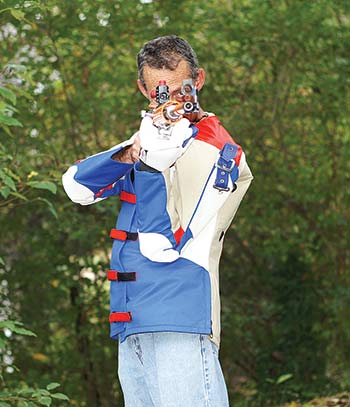Mastering Your AR — Getting the Most Out of Your Rifle
Most AR-15 folks are gearheads. That’s good. Me too. We like the tech, the industry and this magazine. I devote a lot of my content to the tech aspect of the AR-15. But this time around I want to offer a few ideas on the most important part of an AR-15: the nut behind the stock.
The ultimate goal of the cool tech, after all, is it somehow makes it easier to hit the target, faster and closer to its center. Elevating shooting skill is a major factor in how much enjoyment you get and how effective you are with the AR-15 as well as evaluating the efficiency of the technology.
Umpteen years ago, I was squadded with a Captain from the USMC Rifle Team for the President’s Match at Camp Perry. Turns out we had similar upbringings and shooting histories. I have considered the essence of what Capt. Hammel said many, many times over all the years: “When I was a kid I could hit anything with my .22 rifle, it was just experience and feel. I could shoot bees out of the air, hit jackrabbits at 200 yards… I never changed my sights, just my aim. It wasn’t until I got on the Rifle Team and learned just how complicated shooting is, and then I realized all that must have been impossible…” All the science and math behind making an accurate shot, especially at distance, relies strongly on knowledge. However, the true fundamentals, the most basic elements, are stupidly simple and completely necessary: put the sights on the target, then pull the trigger without moving the sights.
If it’s an iron-sight system, focus on the front sight. It truly does not matter how the target appears through the sighting system. It can be perfectly clear, or something more akin to a gray blob. Doesn’t matter. If you can see the front sight clearly, you can shoot a good group. To get the sight picture, the relationship between rear sight, front sight and target, I center the top of the front post in the center of the rear aperture.
The whole “pull-the-trigger-without-moving-the-sights” thing gets a huge amount of help from a better trigger––choose your aftermarket AR-15 trigger carefully, not all are reliable.
Triggering mechanics are very important to good groups. Without good technique and, mostly an awareness of technique, sight movement, which of course is also rifle movement, can be introduced. Better control comes when only the first pad of the index finger touches the trigger face. Of massive importance is that the trigger finger touches nothing else! Don’t let it push in on the pistol grip. Because of the relatively very short distance from trigger face to the leading edge of the pistol grip, it’s a challenge for those with even mid-size hands to get handhold position. Most find they have better command when they have to “reach” their finger a little to engage the trigger––thicker front to back pistol grips help.
Press the trigger using only pressure from the finger, and move the trigger straight back. It’s a completely isolated movement when done right. Watch for movement or tension in the first finger joint (the one nearest the hand). This first joint should be dead still. If you dry fire a rested rifle and watch sight movement, this should teach you all you need to know. Make adjustments in technique until it quiets down. Watch especially for side to side or tilting—or both—sight movement, usually caused by either the trigger finger pressing against the pistol grip, or first-joint finger movement or having the finger too far “across” the trigger face.
If you’re firing shots rapidly, keep the finger in contact with the trigger face shot to shot. As you release the trigger forward after firing, with a little directed effort, you can feel the moment the mechanism resets so the trigger can be pulled again. The little “click” is the disconnector handing off the hammer to the sear. One of the things I don’t like about aftermarket 2-stage triggers is their reset distance is huge compared to a standard-style single-stage. You will shoot better if you can learn to “ride” the trigger back and forth for each shot rather than taking your finger off and back on the trigger face for each shot.
I grasp the pistol grip with a good deal of pressure, and there’s more gripping power coming from my ring and little finger. I don’t grip at all with my thumb. There’s a sympathetic relationship, a natural “pinching” between the thumb and index finger, and I want to maintain free movement in the triggering finger.
Well, I’m prepared to get hammered on for this next bit of wisdom, but here it goes: I find it difficult to shoot an AR-15 well when I hold the rifle straight up and down. Because the pistol grip is hanging down so far underneath the works, I want to roll the rifle over toward my face (counterclockwise for a right-handed shooter) to get a stronger right hand and arm position and not tilt my head over to the right. Rotating the rifle raises the pistol grip and lets me seat the buttplate better into my shoulder while bringing the rifle over my body centerline for a better-balanced stance. If you’re using an optical sight with a conventional reticle, it’s easy enough to adjust the mounting (just rotate the scope in its rings) so it reads level when the rifle is canted the degree you need. Other types of sights are a simple matter of a zero adjustment.
This advice is a tough sell, but most competitive riflemen cant a rifle as second nature (I also let the rifle fall over in the other direction, clockwise, firing from the sitting position to avoid the neck strain and sight drift from trying to keep my head upright). If you experiment with cant, you’ll also see the consistency of your position will improve. It becomes more natural. For me, the shooting position improves so much that indexing the rifle onto the same point and plane each shot is effortless.
If your AR-15 has a free-float-style fore-end, this caveat won’t matter, but if it’s a conventional-style fore-end (2-piece plastic handguard), do not rest the fore-end on anything and don’t apply tension from the sling. Just hold the fore-end. If, for instance, you are able to use a fencepost or other rest to steady your aim, place your hand on the rest, and then the rifle on your hand. Point of impact will—not can—change if different pressures are applied. It has to do with having the handguard attachment also attached to the barrel, and that’s what free-float tubes eliminate.
One parting note: Just because an AR-15 produces virtually no detrimental recoil doesn’t mean it should be held lightly! Firmness is key to firing any rifle well outdoors from an unsupported position. I hold the rifle hard enough I can suspend it upside down using only my supporting hand and arm, just as much as I ever did the M1A. I also put a high amount of cheek pressure down onto the buttstock; this holds the sights and me in place.
Shameless Self-Promotion
Glen is a card-carrying NRA High Master competitive shooter and earned his classification in NRA High Power Rifle using an AR-15 service rifle. For more information, check out ZedikerPublishing.com or BuyZedikerBooks.com.





